Kinya Ishikawa, potter-1001 Pots founder
“Presenting alone is just a demonstration from one artist. But presenting as a group, it becomes a movement.”

I phoned Kinya Ishikawa on a snowy Saturday morning knowing little else about him other than that he’d founded 1001 Pots, the largest pottery exposition in North America. What I discovered was so much more than the history of how the expo began: a beautiful and unique love story; a character transformation; and a newfound appreciation for an art form I hadn’t dabbled in since childhood.
Thank you to Ottawa, Ontario’s Michelle Gauthier—a friend and past 1001 Pots attendee—for opening my eyes to Kinya.
Planting the seeds
Looking back on the path that led Kinya from Tokyo, Japan to Val-David, Quebec, you can see where the seeds that would go on to blossom into a vast ceramic garden started to take root.
One of the earliest kernels took the shape of the late Kensuke Ishizu, founder of Japanese clothing company Van Jacket Inc. Kinya worked as a designer at Van Jacket after graduating from the Takanawa Gakuen school in 1964 and dropping out of university a year later. Never one for formal learning, he found greater fulfillment learning how to design on the job than he did sitting in a classroom.
“Mr. Ishizu was a very special person,” says Kinya. “His company wasn’t about making money, it was more about making a revolution for young people in Japan.”
Kinya describes how his boss and mentor bought a block of buildings in Tokyo and transformed each one into a unique cultural experience. One was Van Jacket, another was a restaurant, another a flower shop. But these weren’t just ordinary stores. “He made it his type of restaurant, his kind of flower shop. In that period, it was only older ladies selling flowers. But he brought in rock music and long hair (on men)… He wanted to change the culture for young Japanese people.”
Kinya had great respect and admiration for Kensuke. So, when his employer recommended that he go to North America to expand his horizons, Kinya took the advice to heart. In true Kinya fashion, however, he took a very untraditional path to make that move.
Kensuke was a true entrepreneur, and seemed to apply his skills to any field that piqued his interest. When he realized Japan was without an Olympic bobsled team, he became chairman of the country’s bobsled committee and put together a team for the 1969 Lake Placid Bobsleigh World Cup. Kinya was named to the team, and that’s how he got his ticket to North America.
Stumbling onto pottery
After finishing last in the competition, the rest of Team Japan returned home. But Kinya stayed on and moved to Montreal, Quebec. He spoke no French and very little English, so he knew his job prospects were limited. When he saw a sign for a pottery studio in Old Montreal, he made them an offer: he would work as a janitor in exchange for free boarding.
Kinya took the job as a means to an end. But it soon became clear that the pottery studio was where he was destined to be. He paid close attention to the students’ work, and before long, he tried his hand at the wheel.
“I didn’t have any background of making pottery,” he says. “But in Japan, since we were children, we always used handmade pottery.” His talent was abundant, and he took advantage of every opportunity he had to hone his craft, including participating in a workshop at the Salon des métiers d’art.
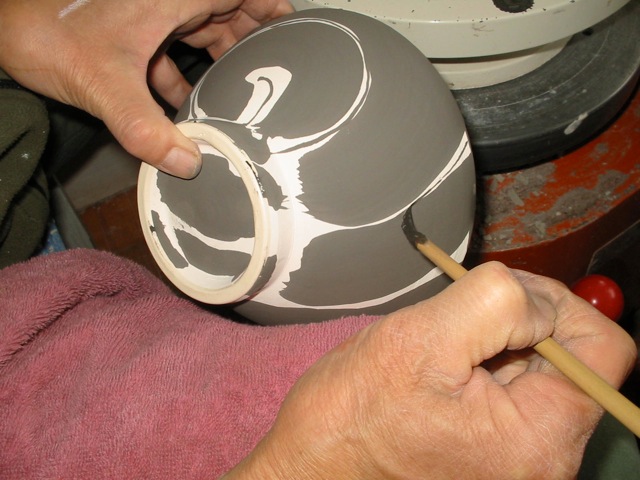
Kinya at work
The universal language
While Kinya was coming into his own as a potter, fate pointed the way to another great love of his life. Having little money, there were few options for entertainment during his leisure time. So, he headed to the library at the University of Quebec to indulge his love of reading. He was discouraged to find that there were almost no English or Japanese books available. But that didn’t stop him from making regular visits to the facility.
Language was a barrier to his reading, but not to his communicating with librarian Marie-Andrée Benoit. She understood only French, and to complicate things further, was a non-speaking deaf who had lost her hearing at age six. Still, absolute silence didn’t prevent the pair from making a profound connection almost instantly. “We had a passion,” says Kinya. The two spent hours consulting English-to-French and French-to-English dictionaries, then translating their sentiments into hastily scribbled notes.
Over time, the couple developed their personal version of sign language. Like Kinya, his future wife preferred to learn in her own way. Now married for more than 40 years, the couple communicates with each other and their two grown sons in French; Marie-Andrée lip reads and re-learned to speak by feel.
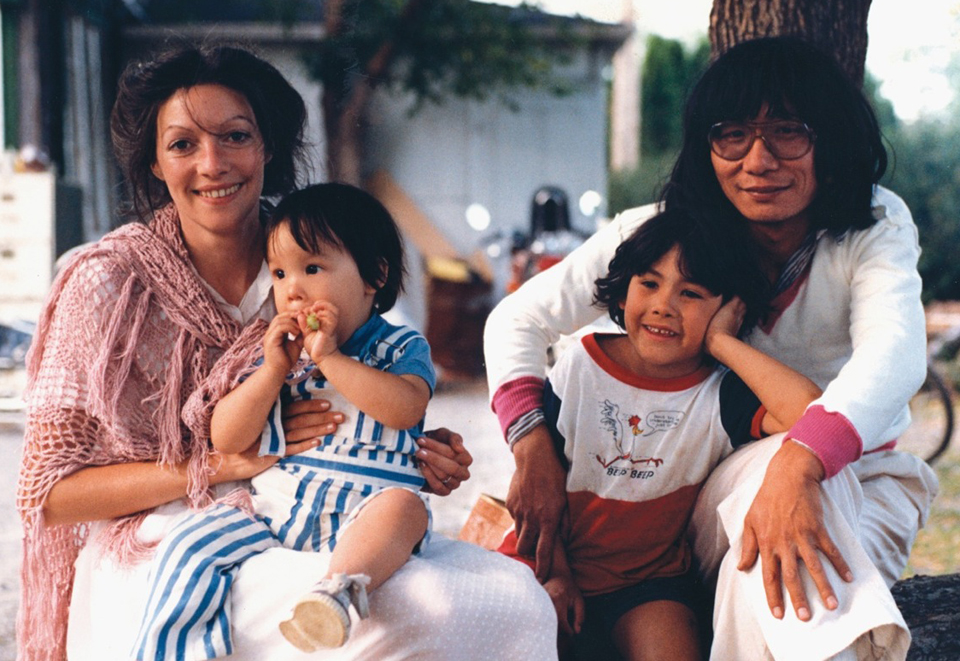
From left: Marie-Andrée, Kei Jonathan, Tesson David, Kinya c. 1980
Pottery as art
Before Kinya and Marie-Andrée’s children, there came a move to Boucherville, a city a few kilometres south of Montreal. Kinya earned enough money selling his pottery to be able to open his own studio, and in 1972, that’s exactly what he did.
Inspired by Kensuke’s open door policy, Kinya constantly invited people to visit his Boucherville studio and share in his work. But his focus was on selling one-of-a-kind pieces and establishing himself as a potter. “I had a lot of ambition in that period,” he says. “I really wanted to be a good artist.”
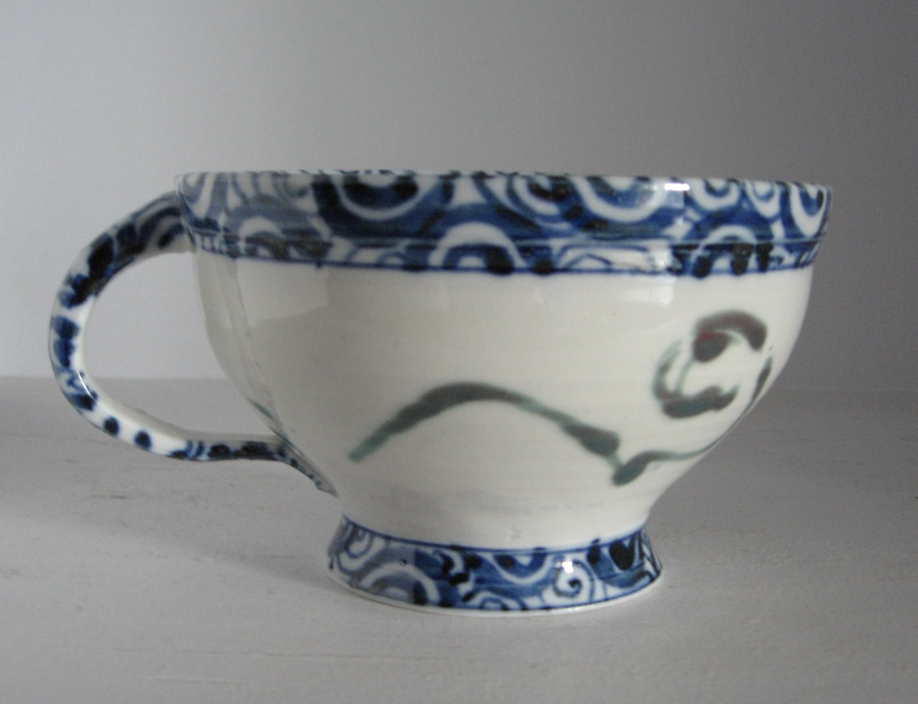
Kinya’s handiwork
His work was shown in galleries across North America and Japan, and he was making a good living off his creations. Still, Kinya looks back on his approach to pottery then as selfish and even “stupid.” He hadn’t yet learned to truly appreciate the communal nature of his craft.
Defining moments
One of the most profound and defining events in Kinya’s life—and career—was meeting the late Bernard Leach, celebrated British potter and co-founder of the Leach Pottery, “the most famous and certainly the most influential studio pottery in the world.” The occasion presented itself in 1979, when Kinya was invited to display his work in a ceramic exhibition at the gallery in the Victoria and Albert Museum (VAM) in London.
Prior to meeting with the gallery’s curators, Kinya travelled to St. Ives where the then-85-year-old potter lived. Bernard’s assistant allotted Kinya only 15 minutes to speak with the celebrity, but it didn’t take even that long for Bernard to extend the invitation by several hours. “He invited me to stay for dinner,” says Kinya. “This was really a privilege, being invited to stay by such a famous ceramist.”
Of course, Kinya was quick to accept the offer. Over “lousy chicken” and excellent conversation, he found his outlook on pottery slowly beginning to change. Bernard spoke of his dear friend and co-founder of the Leach Pottery, Shoji Hamada, himself a well-known and respected potter. Bernard talked about Hamada’s work and showed Kinya his massive collection of books on ceramics and other treasures. The images made a great impact on Kinya. But perhaps even more influential was the kinship Bernard shared with Hamada, who had recently passed away.
As the evening wore on, Bernard pulled out the sake and asked Kinya to choose a small cup. The elder potter’s eyesight was quite poor by this time, and when he chose a cup for himself, Kinya noticed that it was in fact an egg stand. “I said, ‘Mr. Leach, you’re choosing an egg stand,’” recalls Kinya. “He said, ‘Who cares? I’m drinking sake.’” It was a glib comment, but it stayed with Kinya well into the next day.
When he returned to London for his meeting at VAM, Kinya was put off by all the logistics and red tape surrounding his potential show. He found himself thinking back to Bernard’s egg stand, and reflecting on what really mattered to him about pottery. It was about creating something that could be shared with other people, not about producing something that would remain untouched in a museum.
“At the last minute, I lost interest and I quit,” he says. He washed his hands of the exhibit, and returned to Quebec a new man with a new vision.
At home in the mountainside
By 1980, sons Tesson David and Kei Jonathan had arrived, and the family was ready for life in a smaller town. They moved to the Val-David mountainside and took over a retired youth hostel, which Kinya converted into both a studio and a home. He shifted his focus from making one-of-a-kind ceramics to objects that could be shared and enjoyed by many people on a daily basis. He also stayed in touch with Bernard, recording audio tapes for his new friend until he passed away in 1981.

Marie-Andrée at work in the family’s Val-David studio
Five years later, Kinya had the opportunity for another big trip, one that put the finishing glaze on his newfound approach to the world of ceramics. He was awarded a grant from the Quebec Arts Council to spend a year practicing his craft anywhere in the world. “I decided to go back to Japan just to see what pottery is in Japan,” he says.
True to form, he didn’t enroll in formal lessons. Instead, a friend named Kaki set him up in a studio of his own, where he was free to experiment and grow. Kaki was a cabinetmaker, and he very much lived by the same code as Kensuke, collaborating with other artists and producing works that had real-life, everyday applications.
Pottery as shared experience
After having spent time with Bernard and Kaki, Kinya realized he’d be much happier surrounding himself with people, sharing and teaching his craft rather than merely displaying his creations. In 1988, he moved down from the mountainside and into the heart of Val-David’s village. Then he started thinking hard about how to collaborate with other potters, rather than working in isolation.
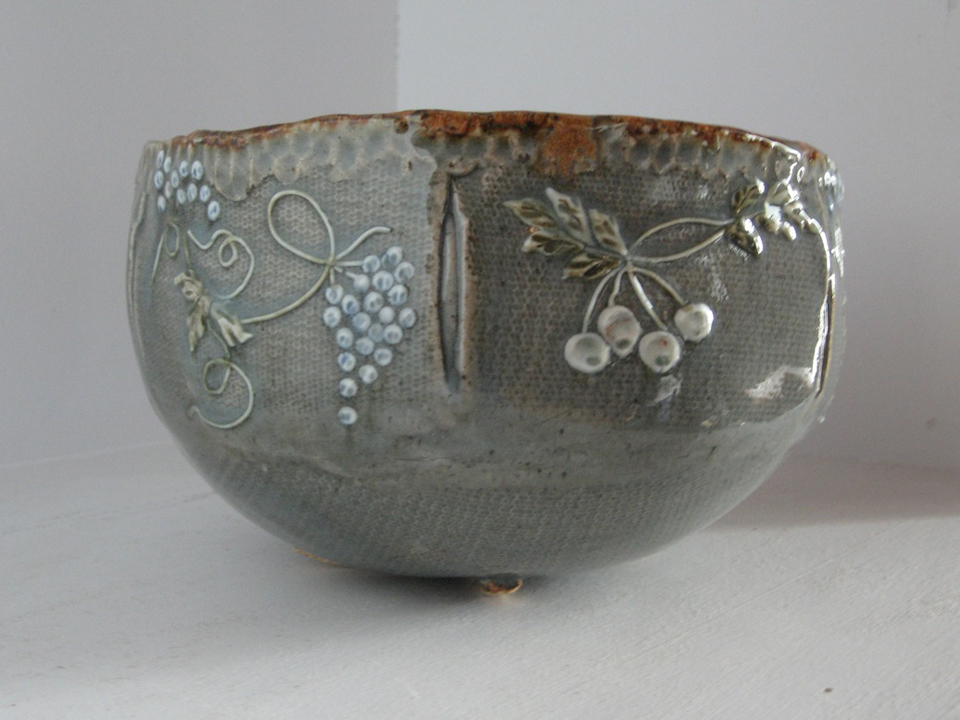
One of Marie-Andrée’s creations
“Before (meeting Bernard and Kaki), I was promoting myself and my work,” he says. “But it’s not good enough. We should promote together. Otherwise, nobody understands about our work. Presenting alone is just a demonstration from one artist. But presenting as a group, it becomes a movement. If the movement continues, it becomes the fashion. If we continue the fashion, one day it becomes a culture.”
Promoting the culture of pottery and ceramics was important to him because so few things today are handmade. More than ever before, he saw the need to create pottery that could be used on a daily basis. Something that “touches hands, touches lips,” he felt, should be made by hand.
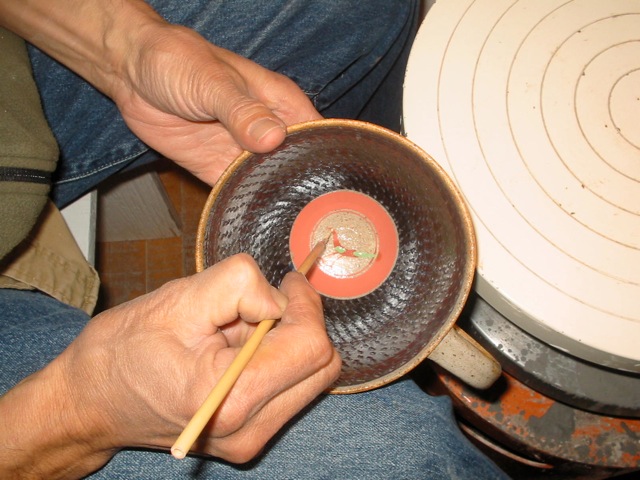
1001 Pots
With the seeds firmly rooted, and nourished by Kinya’s wisdom and experience, his brainchild and legacy was finally ready to blossom. In the summer of 1989, Kinya invited about 50 other potters to show their work in Val-David. “There were nearly 1,000 pieces,” he says. “We called it 1001 Pots.”

1001 Pots
Since then, the event has bloomed into the largest pottery exposition in North America. Now in its 23rd year, 1001 Pots includes a range of displays and activities, such as pottery workshops, a children’s ceramics show, a tearoom and several gardens. Up to 100,000 people attend the annual month-long event, which runs in mid-summer and features work by more than 100 potters from around the world.
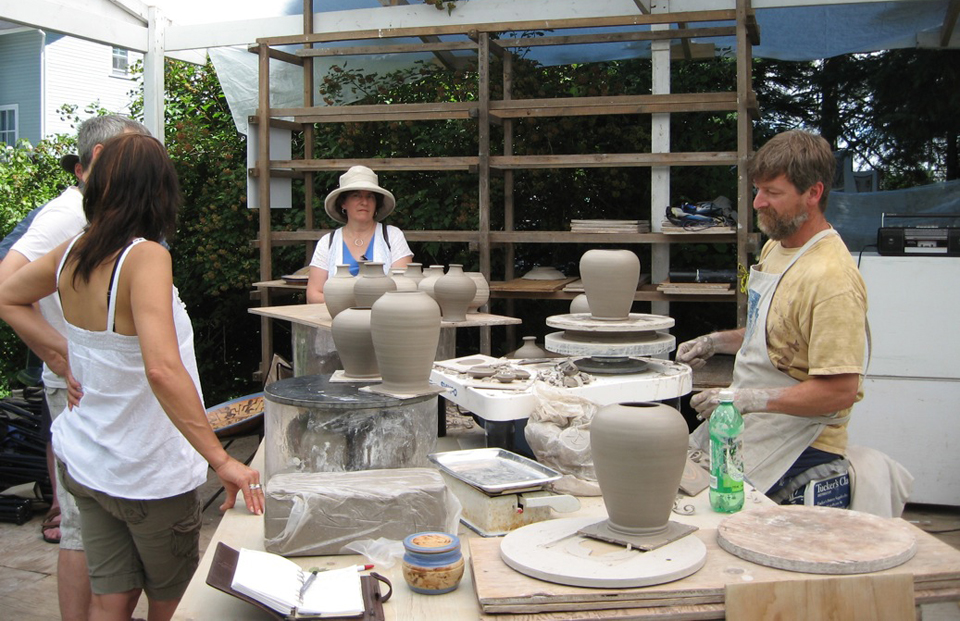
1001 Pots
Kinya admits that he was thinking of stopping the event in 2010. At nearly 70 years of age, he was getting ready to slow down and focus on a simpler life with Marie-Andrée. “I’d done it for more than 20 years. I didn’t need to show my work anymore.”
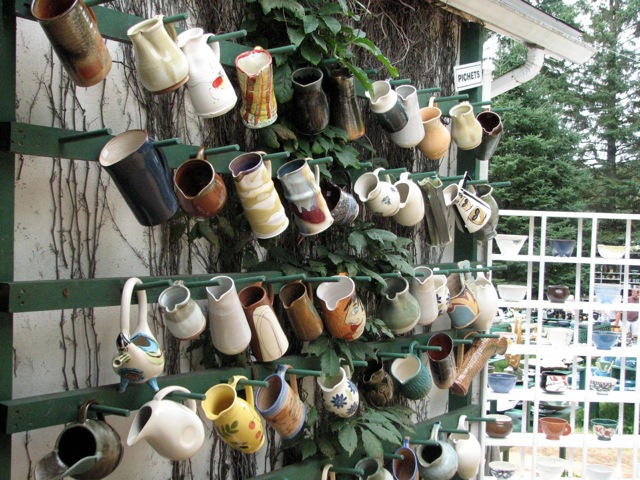
Wall of Mugs, 1001 Pots
But the people of Val-David spoke up, letting him know just how important his contribution has been. “They told me, ‘Kinya, you think 1001 Pots belongs to you, but not anymore; it belongs to our village.’ That cut to my heart because they are very proud of having 1001 Pots.”
Just as Kinya envisioned: the Ishikawa Pottery—a culture of potters.
* * *
To learn more about 1001 Pots, visit 1001pots.com or email Kinya at [email protected].
 Kickass Canadians
Kickass Canadians
Everything you say in the article rings true, I live and work as an artist in the Laurentians and it is difficult to express just how much having Kinya as an inspiration has made a difference to so many artists’ lives… both potters and painters. I often joke with him that I wish he could organize the painters world as successfully. He says it is up to us… Very true!
Hi Karen – I’m glad the piece hit home for you! Kinya was an absolute joy for me to discover.
I had the pleasure of visiting Kinya Ishikawa’s studio up in the hills outside Val David in the fall of 1985. I and two other ladies whose husbands were attending a conference at La Sapiniere decided to go looking for his place, and stumbled upon it on our drive. He was SO gracious, and even took us upstairs to see the gorgeous sink he’d made for their bathroom. It featured a beautiful iris design fired into the finish. Sadly, we were not able to meet his wife, as she was out. It was a wonderful day, and I was just telling our grown daughter about it today. I hope to make it up to Val David again, someday, and visit the 1001 Pots Festival!
Thanks for the comment, Susan. I was just at 1001 Pots today and finally met Kinya (and his wife) in person. Gracious is a great word for him. I hope you and your daughter get to the expo sometime soon.
I have known Kinya now for 10 years through the Muhlstock family in Val-David. I stopped in on him recently with my partner, Bess Muhlstock, to wish him and Marie-Andrée our best wishes for the New Year. He received us in such a kind manner; we were extremely touched. I wish to say that his kindness and serenity and attention for others is truly an inspiration.
What a coincidence, Paul – I was just talking to Kinya this morning. So nice to get your comment, and I couldn’t agree more. He and his wife are very special, welcoming people. They’ve got a magic touch.
My husband and I, at breakfast in our home in New Jersey, were admiring our Kinya-created pitcher this morning, and I decided to learn more about him and discovered your website. We have attended every 1001 Pots show since its inception and enjoy it more and more each year; it is an integral part of our summer. I am grateful to you for showing me Ishikawa’s history. And of course I am sincerely grateful to him for the work he does on his own pottery, as well as on the 1001 Pots exhibition each summer. The number of pieces of his and of other potters we have bought for ourselves and friends grows each year and brightens our lives.
Freda-Lee, I’m thrilled you found this site! Thank you so much for sharing your experiences of 1001 Pots. Kinya is a lovely man, and his story remains one of my favourites. Perhaps I’ll run into you at the exhibition one of these summers…